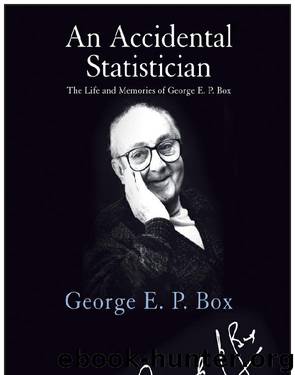An Accidental Statistician by George E P Box

Author:George E P Box [Box, George E P]
Language: eng
Format: epub
ISBN: 9781118400883
Publisher: John Wiley & Sons, Incorporated
Published: 2013-03-11T04:00:00+00:00
Thus, what came out of the research on the automatic optimizer was much more than was our initial intention. This confirmed what we believed: That the best way to develop theory is to study practical examples carefully.
In addition to its impact on our ideas about control, the book has had a large influence on economics and business. Also, econometric models have a lot in common with chemical kinetic models used in describing complex reaction systems. Gwilym and I both had some experience with these. Later, several quite different theoretical kinetic models were put forward by different sets of chemical engineers and chemists to explain the production of ozone and the subsequent pollution of the atmosphere. The problem was that all the kinetic models contained very large numbers of parameters, which it was quite impossible to estimate from the available data—the same problem that arose in economic modeling. We believed that a good approach is that, rather than start with the model, you should start from the data and produce a simple dynamic-stochastic model empirically, and then try to relate this to theoretical mechanisms that could be identified. This has turned out to be a very valuable approach. At one time we had a joint project along these lines with the economists at Madison, but I am sorry to say that nothing came of it.
When it came time for my students to pick a thesis topic, I usually discussed their interests with them and then suggested possibilities for further pursuit. Three of my students, however, came to Madison with a predetermined interest in time series. Earlier, Dean Wichern, Paul Newbold, and Larry Haugh had written good theses on the subject. As a matter of timing, however, the students who came after Time Series was published in 1970 had more familiarity with the subject. These included Bovas Abraham, Johannes Ledolter, and Greta Ljung.
Bovas Abraham was from southern India. Before coming to Madison in 1971, he had received a Master's degree in statistics from the University of Kerala, where, for a time, he also taught, and he had also spent two years teaching secondary school in Cape Coast, Ghana. He had then received another master's degree from the University of Guelph. Bovas had received a partial research assistantship from Wisconsin, and shortly after moving to Madison, he came to talk to me about it. Before he left my office, he agreed to plot some difficult diagrams for me. Only much later did he tell me that he had had no idea how to do this. He persisted, however, and with great enterprise, he eventually discovered a computer program that could plot the graphs. After a year, Bovas passed his qualifying exams and asked me if I would supervise his dissertation.9
I insisted that my students produce a well-written thesis, and worked hard with both native and non-native speakers of English to make them understand the importance of this. Because I traveled a great deal in the 1970s, I often read parts of a student's
Download
This site does not store any files on its server. We only index and link to content provided by other sites. Please contact the content providers to delete copyright contents if any and email us, we'll remove relevant links or contents immediately.
| Biomathematics | Differential Equations |
| Game Theory | Graph Theory |
| Linear Programming | Probability & Statistics |
| Statistics | Stochastic Modeling |
| Vector Analysis |
Weapons of Math Destruction by Cathy O'Neil(5046)
Factfulness: Ten Reasons We're Wrong About the World – and Why Things Are Better Than You Think by Hans Rosling(4031)
Factfulness_Ten Reasons We're Wrong About the World_and Why Things Are Better Than You Think by Hans Rosling(2758)
Descartes' Error by Antonio Damasio(2744)
A Mind For Numbers: How to Excel at Math and Science (Even If You Flunked Algebra) by Barbara Oakley(2694)
TCP IP by Todd Lammle(2646)
Applied Predictive Modeling by Max Kuhn & Kjell Johnson(2487)
Fooled by Randomness: The Hidden Role of Chance in Life and in the Markets by Nassim Nicholas Taleb(2420)
The Book of Numbers by Peter Bentley(2411)
The Tyranny of Metrics by Jerry Z. Muller(2407)
The Great Unknown by Marcus du Sautoy(2192)
Once Upon an Algorithm by Martin Erwig(2152)
Easy Algebra Step-by-Step by Sandra Luna McCune(2121)
Practical Guide To Principal Component Methods in R (Multivariate Analysis Book 2) by Alboukadel Kassambara(2099)
Lady Luck by Kristen Ashley(2079)
Police Exams Prep 2018-2019 by Kaplan Test Prep(2039)
Linear Time-Invariant Systems, Behaviors and Modules by Ulrich Oberst & Martin Scheicher & Ingrid Scheicher(1986)
All Things Reconsidered by Bill Thompson III(1964)
Secrets of Creation, Volume 1: The Mystery of the Prime Numbers by Watkins Matthew(1870)
